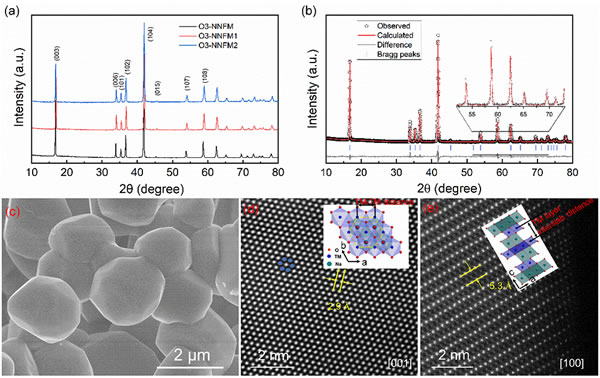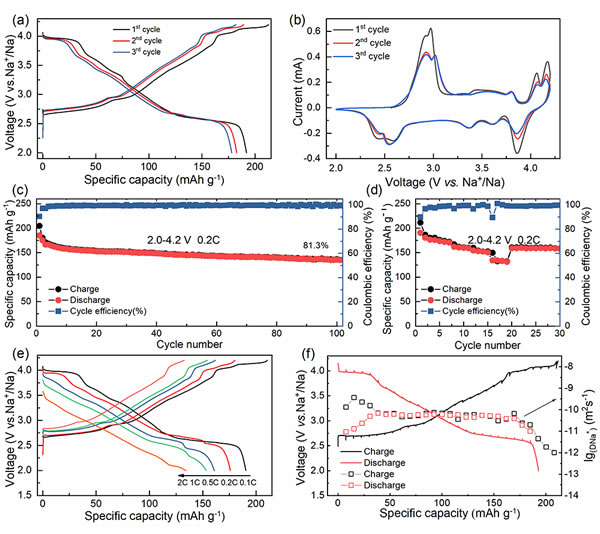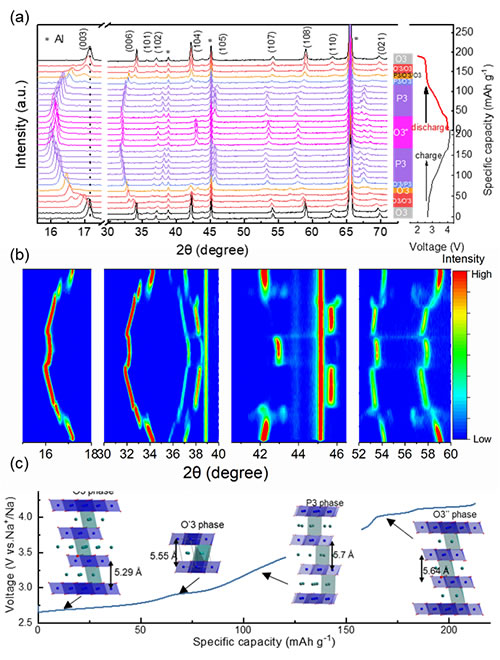Due to the abundant resources and low cost of sodium resources, room temperature sodium ion batteries show great potential for future large-scale energy storage applications. In the past two years, they have successfully implemented application demonstrations on low-speed electric vehicles and energy storage power stations. O3 layered transition metal oxide has the advantages of simple preparation process, high specific capacity, high coulombic efficiency in the first week and environmental friendliness, which has attracted extensive attention from researchers. In order to further develop sodium ion battery cathode materials with high capacity and long cycle performance, the development of high nickel O3-NaTMO2 cathode materials is expected to be an effective strategy to solve this problem. At present, the Ni content in the NCM (nickel cobalt manganese) material system of lithium ion batteries can be increased to more than 80%. The cobalt-free high nickel positive electrode is also an important direction for current lithium ion batteries, but further reductions in the content of Co have encountered great The technical bottleneck, which also limits its material cost to further decline. In the sodium ion battery system, the situation is different. Due to the large difference in the radius of Ni and Na, there is almost no mutual occupation of Ni and Na in the layered oxide, which shows that the development of high-performance cobalt-free high nickel The layered oxide positive electrode of sodium ion battery is more likely. Recently, under the guidance of researcher Hu Yongsheng, associate researcher Lu Yaxiang, and doctor Rong Xiaohui, doctoral students Ding Feixiang and Zhao Chenglong from the Institute of Physics, Chinese Academy of Sciences/National Research Center for Condensed Matter, Beijing Key Laboratory of Clean Energy, synthesized a co-precipitation method. A series of O3-Na[NixFeyMn1-xy]O2 (x=0.6, 0.7 and 0.8) cathode materials (Figure 1), by combining electrochemical testing and in-situ/ex-situ structural characterization, a high-nickel O3 type cathode material was systematically studied The relationship between sodium storage mechanism, nickel content (iron-manganese replacement) and sodium storage performance. The results show that the material with the composition of Na[Ni0.60Fe0.25Mn0.15]O2 (O3-NNFM) has a good overall performance, showing a specific capacity of 190 mA·h/g in the voltage range of 2.0-4.2 V (Figure 2), and accompanied by the phase transition process of O3-O'3-P3-O3'' (Figure 3). Although the phase transition process is highly reversible, the O3″ phase at high voltage shows poor chemical stability and sodium ion diffusion kinetics due to its low sodium content and large volume deformation. In addition, after cycling at a high operating voltage of 4.2 V, obvious solid electrolyte mesophase and cracks were formed on the surface of the electrode material. By optimizing the charging cut-off voltage, it was found that when the cut-off voltage is reduced to 4.0 V, it can effectively avoid the formation of the O3" phase and inhibit the decomposition of the electrolyte, and obtain excellent half-cell and full-cell electrochemical performance, and its comprehensive performance is even excellent. In some reported cobalt-containing high-nickel NNCM cathode materials. Further, the positive electrode material was used as a model material and the high-capacity phenolic resin-based hard carbon negative electrode (ACS Energy Lett., 2019, 4, 2608-2612, DOI: 10.1021/acsenergylett.9b01900) developed by the research group was assembled into a sodium ion full battery To obtain a specific energy of 345 Wh/kg (calculated based on the mass of the positive and negative active materials). This work not only provides a high-capacity cathode material with development potential for sodium ion batteries, but also conducts an in-depth analysis of the cause of the failure of the material, and provides new ideas for the design of cathode materials for high specific energy sodium ion batteries. In future work, it is expected to achieve the cycle stability of such materials under high voltage through surface coating, trace doping, and electrolyte optimization, and further improve the energy density of the entire battery through sodium supplementation technology. The research results were recently published on Energy Materials Storage under the title A Novel Ni-Rich O3-Na[Ni0.60Fe0.25Mn0.15]O2 Cathode for Na-Ion Batteries. Related work was supported by the National Natural Science Foundation of China (51725206, 51421002), the Chinese Academy of Sciences Class A Strategic Leading Science and Technology Project (XDA21070500), the Beijing Municipal Science and Technology Commission (Z181100004718008), and the Beijing Natural Science Foundation-Haidian Original Innovation Joint Fund (L182056). House Kitchenware,Cooking Ware,Kitchenware Items,Stainless Steel Kitchenware Xinhe Stainless Steel Products Co., Ltd. Of Pengjiang District Jiangmen City , https://www.sinkhall.com
Figure 1. (a) XRD patterns of series O3-Na[NixFeyMn1-xy]O2 (x=0.6, 0.7 and 0.8 correspond to O3-NNFM, O3-NNFM1 and O3-NNFM2) samples respectively, (be) O3-Na[ Refined XRD patterns, SEM and STEM characterization of Ni0.60Fe0.25Mn0.15]O2 
Figure 2. O3-NNFM electrode in the 2.0-4.2 V voltage range (a) the first three weeks of charge and discharge curve, (b) CV curve, (c) cycle performance, (d) and (e) rate performance 
Figure 3. O3-NNFM material (a, b) in-situ XRD pattern and 2D contour map during the first cycle charge and discharge, (c) schematic diagram of the structure evolution during charging 
Figure 4. Charge-discharge curves of O3-NNFM positive and hard carbon negative batteries in the first three weeks in the 0.5-4.2 V voltage range